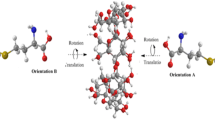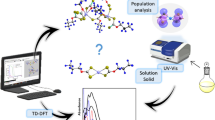Abstract
Cation–π complexes between several cations (Li+, Na+, K+, Be2+, Mg2+, and Ca2+) and different π-systems such as para-substituted (F, Cl, OH, SH, CH3, and NH2) benzene derivatives have been investigated by UB3LYP method using 6-311++G** basis set in the gas phase and the water solution. The ions have shown cation–π interaction with the aromatic motifs. Vibrational frequencies and physical properties such as dipole moment, chemical potential, and chemical hardness of these compounds have been systematically explored. The natural bond orbital analysis and the Bader’s quantum theory of atoms in molecules are also used to elucidate the interaction characteristics of the investigated complexes. The aromaticity is measured using several well-established indices of aromaticity such as NICS, HOMA, PDI, FLU, and FLUπ. The MEP is given the visual representation of the chemically active sites and comparative reactivity of atoms. Furthermore, the effects of interactions on NMR data have been used to more investigation of the studied compounds.





Similar content being viewed by others
References
Hunter CA, Sanders JKM (1990) The nature of π–π interactions. J Am Chem Soc 112:5525–5534
Hashimoto S, Ikuta S (1999) A theoretical study on the conformations, energetics, and solvation effects on the cation–π interaction between monovalent ions Li+, Na+, and K+ and naphthalene molecules. J Mol Struct Theochem 468:85–94
Ikuta S (2000) A theoretical study on the conformations and energetics on the cation–π interaction between monovalent ions (M+ = Li+, Na+, and K+) and anthracene and phenanthrene molecules. J Mol Struct Theochem 530:201–207
Aschi M, Mazza F, Di Nola A (2002) Cation–π interactions between ammonium ion and aromatic rings: an energy decomposition study. J Mol Struct Theochem 587:177–188
Meyer EA, Castellano RK, Diederich F (2003) Interactions with aromatic rings in chemical and biological recognition. Angew Chem Int Ed 42:1210–1250
Salonen LM, Ellerman M, Diederich F (2011) Aromatic rings in chemical and biological recognition: energetics and structures. Angew Chem Int Ed 50:4808–4842
Schneider H-J (2009) Binding mechanisms in supramolecular catalysis. Angew Chem Int Ed 48:3924–3977
Burley SK, Petsko GA (1985) Aromatic-aromatic interaction: a mechanism of protein structure stabilization. Science 229:23–28
Bhattacharyya R, Samanta U, Chakrabarti P (2002) Aromatic-aromatic interactions in and around alpha-helices. Protein Eng 15:91–100
Janiak C (2000) A critical account on pi–pi stacking in metal complexes with aromatic nitrogen-containing ligands. J Chem Soc Dalton Trans 21:3885–3896
Dougherty DA (1996) Cation–π interactions in chemistry and biology: a new view of benzene, Phe, Tyr, and Trp. Science 271:163–168
Steed JW, Atwood JL (2009) Supramolecular chemistry. Wiley-VCH, Weinheim
Ma JC, Dougherty DA (1997) The cation−π interaction. Chem Rev 97(5):1303–1324
Ansorg K, Tafipolsky M, Engels B (2013) Cation–π interactions: accurate intermolecular potential from symmetry-adapted perturbation theory. J Phys Chem B 117(35):10093–10102
Dinadayalane TC, Afanasiev D, Leszczynski J (2008) Structures and energetics of the cation–π interactions of Li+, Na+, and K+ with cup-shaped molecules: effect of ring addition to benzene and cavity selectivity. J Phys Chem A 112:7916–7924
Hassan A, Dinadayalane TC, Grabowski SJ, Leszczynski J (2013) Structural, energetic, spectroscopic and QTAIM analyses of cation–p interactions involving mono- and bi-cyclic ring fused benzene systems. Phys Chem Chem Phys 15:20839–20856
Raju RK, Bloom JWG, An Y, Wheeler SE (2011) Substituent effects on non-covalent interactions with aromatic rings: insights from computational chemistry. Chem Phys Chem 12(17):3116–3130
Hunter CA (2002) In: Proceedings of the National Academy of Sciences 99(8):4873–4876
Wheeler SE, Houk KN (2009) Substituent effects in cation/π interactions and electrostatic potentials above the centers of substituted benzenes are due primarily to through-space effects of the substituents. J Am Chem Soc 131(9):3126–3127
Vijay D, Sastry GN (2010) The cooperativity of cation–PI and PI–PI interactions. Chem Phys Lett 485:235–242
Reddy AS, Vijay D, Sastry GM, Sastry GN (2006) From subtle to substantial: role of metal ions on π–π interactions. J Phys Chem B 110:2479–2481
Reddy AS, Vijay D, Sastry GM, Sastry GN (2006) Reply to “comment on ‘from subtle to substantial: role of metal ions on π−π interactions’”. J Phys Chem B 110:10206–10207
Dinadayalane TC, Hassan A, Leszczynski J (2010) The effect of ring annelation to benzene on cation–π interactions: DFT study. J Mol Struc 976:320–323
Dinadayalane TC, Hassan A, Leszczynski J (2012) A theoretical study of cation–p interactions: Li+, Na+, K+, Be2+, Mg2+ and Ca2+ complexation with mono- and bi-cyclic ring-fused benzene derivatives. Theor Chem Acc 131:1131–1141
Frisch MJ, Trucks GW, Schlegel HB, Scuseria GE, Robb MA, Cheeseman JR, Zakrzewski VG, Montgomery JA, Stratmann JRE, Burant JC, Dapprich S, Millam JM, Daniels AD, Kudin KN, Strain MC, Farkas O, Tomasi J, Barone V, Cossi M, Cammi R, Mennucci B, Pomelli C, Adamo C, Clifford S, Ochterski J, Petersson GA, Ayala PY, Cui Q, Morokuma K, Malick DK, Rabuck AD, Raghavachari K, Foresman JB, Cioslowski J, Ortiz JV, Stefanov BB, Liu G, Liashenko A, Piskorz P, Komaromi I, Gomperts R, Martin RL, Fox DJ, Keith T, Al-Laham MA, Peng CY, Nanayakkara A, Gonzalez C, Challacombe M, Gill PMW, Johnson B, Chen W, Wong MW, Andres JL, Gonzalez C, Head-Gordon M, Replogle ES, Pople JA (2003) Gaussian 03, revision A.7. Gaussian, Inc, Pittsburgh
Miertus S, Tomasi J (1982) Approximate evaluations of the electrostatic free energy and internal energy changes in solution processes. Chem Phys 65:239–245
Boys SB, Bernardi F (1970) Calculation of small molecular interactions by… with reduced errors. Mol Phys 19:553–566
Bader RFW (1990) Atoms in molecules: a quantum theory. Oxford University, New York
Biegler König F, Schönbohm J (2002) Update of the AIM2000- program for atoms in molecules. J Comput Chem 23:1489–1494
Reed AE, Curtiss LA, Weinhold F (1988) Intermolecular interactions from a natural bond orbital, donor-acceptor viewpoint. Chem Rev 88:899–926
Glendening ED, Reed AE, Carpenter JE, Weinhold F (1992) NBO, Version 3.1, Gaussian, Inc., Pittsburgh
Wendt M, Weinhold F (2001) NBOView 1.0; Theoretical Chemistry Institute, University of Wisconsin, Madison
Pulay P, Hinton JF, Wolinski K (1993) In: Tossel JA (ed) Nuclear magnetic shieldings and molecular structure, vol 386. Kluwer, Dordrecht
Hehre WJ, Radom L, Schleyer PR, Pople JA (1986) Ab initio molecular orbital theory. Wiley, New York
Cyranski MK, Krygowski TM, Katritzky AL, Schleyer PvR (2002) To what extent can aromaticity be defined uniquely? J Org Chem 67:1333–1338
Krygowski TM (1993) Crystallographic studies of inter- and intramolecular interactions reflected in aromatic character of pi-electron systems. J Chem Inf Comput Sci 33:70–78
Poater J, Duran M, Sola M, Silvi B (2005) Theoretical evaluation of electron delocalization in aromatic molecules by means of atoms in molecules (AIM) and electron localization function (ELF) topological approaches. Chem Rev 105:3911–3947
Matito E, Duran M, Sola` M (2005) The aromatic fluctuation index (FLU): a new aromaticity index based on electron delocalization. J Chem Phys 122:014109–014117
Garura C, Frontera A, Quin˜onero D, Ballester P, Costa A, Deya` PM (2003) Chem Phys Chem 4(12):1344–1348
Shishkin OV, Omelchennko IV, Krasovska M, Zabatyuk R, Gorb L, Leszczynski J (2006) J Mol Struct 791:158–164
Seal P, Chakrabarti S (2007) Is nucleus-independent chemical shift scan a reliable aromaticity index for planar heteroatomic ring systems? J Phys Chem 111:9988–9994
Ramsden CA (2010) The influence of aza-substitution on azole aromaticity. Tetrahedron 66:2695–2699
Onsager L (1936) Electric moments of molecules in liquids. J Am Chem Soc 58:1486–1493
Garau C, Frontera A, Quin˜onero D, Ballester P, Costa A, Deya` PM (2004) Cation−π versus anion−π interactions: energetic, charge transfer, and aromatic aspects. J Phys Chem A 108:9423–9427
Doerksen RJ, Thakkar AJ (1999) Quadrupole and octopole moments of heteroaromatic rings. J Phys Chem A 103:10009–10014
Author information
Authors and Affiliations
Corresponding author
Electronic supplementary material
Below is the link to the electronic supplementary material.
Rights and permissions
About this article
Cite this article
Khanmohammadi, A., Raissi, H., Mollania, F. et al. Molecular structure and bonding character of mono and divalent metal cations (Li+, Na+, K+, Be2+, Mg2+, and Ca2+) with substituted benzene derivatives: AIM, NBO, and NMR analyses. Struct Chem 25, 1327–1342 (2014). https://doi.org/10.1007/s11224-014-0405-7
Received:
Accepted:
Published:
Issue Date:
DOI: https://doi.org/10.1007/s11224-014-0405-7




